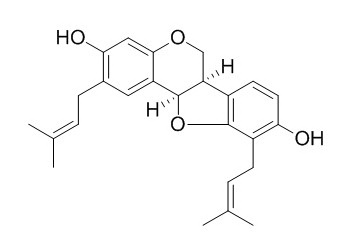Erythrabyssin II
Erythrabyssin II actives against several strains of Staphylococcus and Streptococcus with an MIC range of 0.78-1.56 microg/ml. It inhibits bacterial neuraminidase in a dose-dependent manner with significant inhibition (IC(50)=0.09-3.25 μM).
Inquire / Order:
manager@chemfaces.com
Technical Inquiries:
service@chemfaces.com
Tel:
+86-27-84237783
Fax:
+86-27-84254680
Address:
1 Building, No. 83, CheCheng Rd., Wuhan Economic and Technological Development Zone, Wuhan, Hubei 430056, PRC
Providing storage is as stated on the product vial and the vial is kept tightly sealed, the product can be stored for up to
24 months(2-8C).
Wherever possible, you should prepare and use solutions on the same day. However, if you need to make up stock solutions in advance, we recommend that you store the solution as aliquots in tightly sealed vials at -20C. Generally, these will be useable for up to two weeks. Before use, and prior to opening the vial we recommend that you allow your product to equilibrate to room temperature for at least 1 hour.
Need more advice on solubility, usage and handling? Please email to: service@chemfaces.com
The packaging of the product may have turned upside down during transportation, resulting in the natural compounds adhering to the neck or cap of the vial. take the vial out of its packaging and gently shake to let the compounds fall to the bottom of the vial. for liquid products, centrifuge at 200-500 RPM to gather the liquid at the bottom of the vial. try to avoid loss or contamination during handling.
Journal of Ginseng Research2023, 12.004.
Anticancer Res.2021, 41(3):1357-1364.
J Agric Food Chem.2024, 72(42):23183-23195
Agronomy2023, 13(9), 2410.
Int J Mol Sci.2020, 21(6):2190.
Environ Toxicol.2020, doi: 10.1002
UDC.2020, 19(4).
Phytomedicine.2023, 117:154929.
Food Funct.2021, 12(4):1469-1481.
Heliyon.2024, 10(16):e35645.
Related and Featured Products
J Ethnopharmacol. 2007 Mar 1;110(1):171-5.
Antibacterial pterocarpans from Erythrina subumbrans.[Pubmed:
17055201]
METHODS AND RESULTS:
Seven pterocarpans, erybraedin B (1), erybraedin A (2), phaseollin (3), Erythrabyssin II (4), erystagallin A (5), erythrabissin-1 (6) and erycristagallin (7), two flavanones, 5-hydroxysophoranone (8) and glabrol (9), and one isoflavone, erysubin F (10), were isolated from the stems of Erythrina subumbrans (Leguminosae). Compounds 2 and 4 exhibited the highest degree of activity against Streptococcus strains with an MIC range of 0.78-1.56 microg/ml, whereas compound 7 exhibited the highest degree of activity against Staphylococcus strains, including drug-resistant strains (MRSA and VRSA), with an MIC range of 0.39-1.56 microg/ml. Interestingly, compounds 2, 4, 5 and 7 were more active against several strains of Streptococcus and Staphylococcus than the standard antibiotics vancomycin and oxacillin.
CONCLUSIONS:
These compounds may prove to be potent phytochemical agents for antibacterial activity, especially against the MRSA and VRSA strains.
Bioorg Med Chem Lett. 2011 Oct 15;21(20):6100-3.
Potent inhibition of bacterial neuraminidase activity by pterocarpans isolated from the roots of Lespedeza bicolor.[Pubmed:
21911291]
Bacterial neuraminidase has been highlighted as a key enzyme for pathogenic infection and sepsis.
METHODS AND RESULTS:
Six pterocarpans displaying significant levels of neuraminidase inhibitory activity were isolated from the root bark of Lespedeza bicolor. The isolated compounds were identified as three new pterocarpans (1-3) together with known compounds Erythrabyssin II (4), lespebuergine G4 (5), and 1-methoxyErythrabyssin II (6). The new compounds were characterized as bicolosin A (1), bicolosin B (2), and bicolosin C (3). All compounds inhibited bacterial neuraminidase in a dose-dependent manner with significant inhibition (IC(50)=0.09-3.25 μM).
CONCLUSIONS:
All neuraminidase inhibitors screened were found to exhibit noncompetitive kinetics. The three most potent neuraminidase inhibitors (1, 3 and 6) feature a methoxy substitution on C-1.



